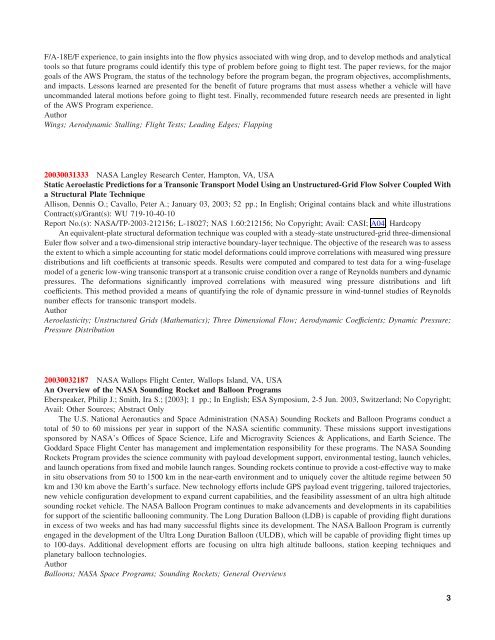Create successful ePaper yourself
Turn your PDF publications into a flip-book with our unique Google optimized e-Paper software.
F/A-18E/F experience, to gain insights into the flow physics associated with wing drop, and to develop methods and analytical<br />
tools so that future programs could identify this type of problem before going to flight test. The paper reviews, for the major<br />
goals of the AWS Program, the status of the technology before the program began, the program objectives, accomplishments,<br />
and impacts. Lessons learned are presented for the benefit of future programs that must assess whether a vehicle will have<br />
uncommanded lateral motions before going to flight test. Finally, recommended future research needs are presented in light<br />
of the AWS Program experience.<br />
Author<br />
Wings; Aerodynamic Stalling; Flight Tests; Leading Edges; Flapping<br />
20030031333 NASA Langley Research Center, Hampton, VA, USA<br />
Static Aeroelastic Predictions for a Transonic Transport Model Using an Unstructured-Grid Flow Solver Coupled With<br />
a Structural Plate Technique<br />
Allison, Dennis O.; Cavallo, Peter A.; January 03, 2003; 52 pp.; In English; Original contains black and white illustrations<br />
Contract(s)/Grant(s): WU 719-10-40-10<br />
Report No.(s): NASA/TP-2003-212156; L-18027; NAS 1.60:212156; No Copyright; Avail: CASI; A04, Hardcopy<br />
An equivalent-plate structural deformation technique was coupled with a steady-state unstructured-grid three-dimensional<br />
Euler flow solver and a two-dimensional strip interactive boundary-layer technique. The objective of the research was to assess<br />
the extent to which a simple accounting for static model deformations could improve correlations with measured wing pressure<br />
distributions and lift coefficients at transonic speeds. Results were computed and compared to test data for a wing-fuselage<br />
model of a generic low-wing transonic transport at a transonic cruise condition over a range of Reynolds numbers and dynamic<br />
pressures. The deformations significantly improved correlations with measured wing pressure distributions and lift<br />
coefficients. This method provided a means of quantifying the role of dynamic pressure in wind-tunnel studies of Reynolds<br />
number effects for transonic transport models.<br />
Author<br />
Aeroelasticity; Unstructured Grids (Mathematics); Three Dimensional Flow; Aerodynamic Coeffıcients; Dynamic Pressure;<br />
Pressure Distribution<br />
20030032187 NASA Wallops Flight Center, Wallops Island, VA, USA<br />
An Overview of the NASA Sounding Rocket and Balloon Programs<br />
Eberspeaker, Philip J.; Smith, Ira S.; [2003]; 1 pp.; In English; ESA Symposium, 2-5 Jun. 2003, Switzerland; No Copyright;<br />
Avail: Other Sources; Abstract Only<br />
The U.S. National Aeronautics and Space Administration (NASA) Sounding Rockets and Balloon Programs conduct a<br />
total of 50 to 60 missions per year in support of the NASA scientific community. These missions support investigations<br />
sponsored by NASA’s Offices of Space Science, Life and Microgravity Sciences & Applications, and Earth Science. The<br />
Goddard Space Flight Center has management and implementation responsibility for these programs. The NASA Sounding<br />
Rockets Program provides the science community with payload development support, environmental testing, launch vehicles,<br />
and launch operations from fixed and mobile launch ranges. Sounding rockets continue to provide a cost-effective way to make<br />
in situ observations from 50 to 1500 km in the near-earth environment and to uniquely cover the altitude regime between 50<br />
km and 130 km above the Earth’s surface. New technology efforts include GPS payload event triggering, tailored trajectories,<br />
new vehicle configuration development to expand current capabilities, and the feasibility assessment of an ultra high altitude<br />
sounding rocket vehicle. The NASA Balloon Program continues to make advancements and developments in its capabilities<br />
for support of the scientific ballooning community. The Long Duration Balloon (LDB) is capable of providing flight durations<br />
in excess of two weeks and has had many successful flights since its development. The NASA Balloon Program is currently<br />
engaged in the development of the Ultra Long Duration Balloon (ULDB), which will be capable of providing flight times up<br />
to 100-days. Additional development efforts are focusing on ultra high altitude balloons, station keeping techniques and<br />
planetary balloon technologies.<br />
Author<br />
Balloons; NASA Space Programs; Sounding Rockets; General Overviews<br />
3
















